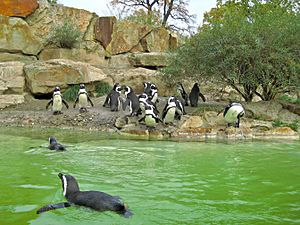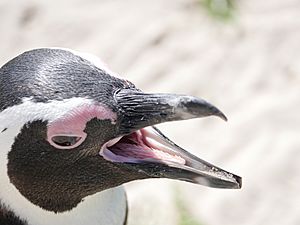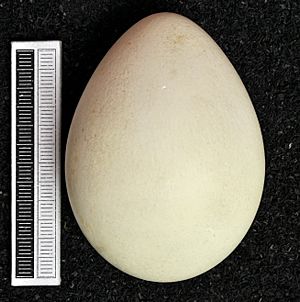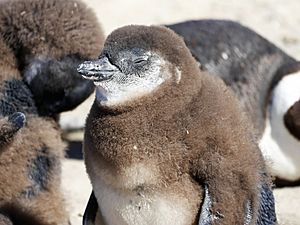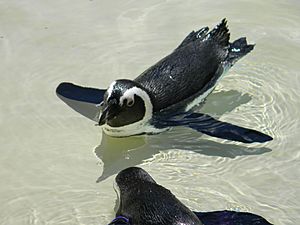African penguin facts for kids
Quick facts for kids African penguin |
|
|---|---|
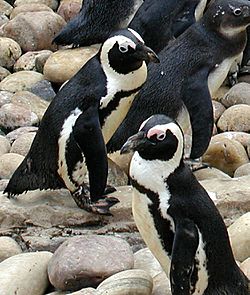 |
|
| Conservation status | |
| Scientific classification | |
| Kingdom: | |
| Subphylum: | |
| Class: | |
| Order: | |
| Family: | |
| Genus: |
Spheniscus
|
| Binomial name | |
| Spheniscus demersus (Linnaeus, 1758)
|
|
The African penguin (Spheniscus demersus) is a special type of penguin. It is also called the Cape penguin or South African penguin. These penguins live only in the waters around southern Africa.
Like all penguins, they cannot fly. They have a smooth body shape and strong, flat wings. These wings work like flippers to help them swim fast in the ocean.
African penguins are great at diving to catch their food. They mostly eat fish and squid. Sadly, the number of African penguins is going down very quickly. Because of this, they are now listed as an endangered species.
Their closest relatives are the Humboldt and Magellanic penguins. These live in southern South America. The Galápagos Penguin is another relative, found near the equator in the Pacific Ocean.
Contents
What Do African Penguins Look Like?

African penguins usually grow to be about 60 to 70 centimeters (24 to 28 inches) tall. They weigh between 2.2 and 3.5 kilograms (4.9 to 7.7 pounds).
They have a black stripe and unique black spots on their chest. Each penguin has its own spot pattern, just like human fingerprints! Above their eyes, they have pink patches. These patches help them stay cool. When a penguin gets hot, more blood flows to these areas. The air then cools the blood, making the patches look more pink.
Male penguins are usually bigger than females. They also have larger beaks. Young penguins do not have the strong black and white patterns of adults. Their upper parts are dark, from grayish-blue to brown. Their light undersides do not have spots or the black band.
Their beak is more pointed than that of the Humboldt penguin. Their special black and white colors help them hide. This is called countershading. The white belly helps them blend in with the bright sky if a predator looks up from below. The black back helps them blend in with the dark water if a predator looks down from above.
People sometimes call them the black-footed penguin. Another name is jackass penguin. This is because they make a loud noise that sounds like a donkey's bray.
Where Do African Penguins Live?
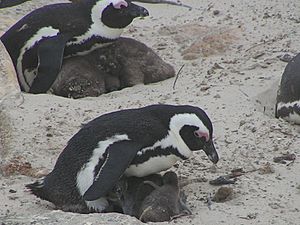
African penguins are found only along the southwestern coast of Africa. They live in groups called colonies. These colonies are on 24 islands between Namibia and Algoa Bay, near Port Elizabeth, South Africa. They are the only penguin species that lays eggs in Africa. Their presence even gave the Penguin Islands their name!
In the 1980s, two colonies started on the mainland near Cape Town. These are Boulders Beach near Simon's Town and Stony Point in Betty's Bay. It is thought that mainland colonies became possible because there were fewer predators. However, leopards have attacked the Betty's Bay colony. There is one other mainland colony in Namibia, but we do not know when it started.
Boulders Beach is a popular place for tourists. People visit for the beach, swimming, and to see the penguins. The penguins there are used to people and will let you get as close as one meter (about 3 feet).
Many zoos around the world also have breeding groups of African penguins. But wild colonies are only found along the southwestern coast of Africa. Sometimes, young penguins might wander outside this area.
How Many African Penguins Are There?
At the start of the 1800s, there were about 4 million African penguins. In 1910, there were about 1.5 million. But by the end of the 1900s, only about 10% of that number remained. Since then, the population has dropped by 95 percent.
By the year 2000, the total number of penguins had fallen to 200,000. In 2010, it was estimated that there were only about 55,000. If this decline continues, African penguins could disappear within 15 years.
In 2008, about 5,000 breeding pairs lived in Namibia. In 2012, about 18,700 pairs were estimated to live in South Africa. Most of these were on St Croix Island in Algoa Bay.
African Penguin Behavior
What Do African Penguins Eat?
African penguins look for food in the open ocean. They chase fish that live in the open water, like sardines and anchovies. They also eat small crustaceans and squid. Penguins usually swim within 20 kilometers (12 miles) of the shore. A penguin might eat up to 540 grams (1.2 pounds) of food each day. But when they are raising older chicks, they might eat over 1 kilogram (2.2 pounds).
In the 1960s, there was a big drop in the number of sardines caught by fishing boats. Because of this, African penguins started eating more anchovies. Anchovies are okay, but they are not as good as sardines. They have less fat and protein.
What penguins eat changes throughout the year. Like many seabirds, their food choices and how well they breed help keep their population stable. Parent penguins protect their young. However, if there isn't enough food, they won't go hungry themselves. This means they might not feed their chicks as much if hunting takes too much time or energy. This can lead to more chicks not surviving when food is scarce.
How Do African Penguins Breed?
African penguins are monogamous, meaning they stay with one partner. They breed in colonies. Pairs usually come back to the same nesting spot every year. African penguins have a long breeding season. Nesting is usually busiest from March to May in South Africa. In Namibia, it peaks in November and December. Female African penguins can lay eggs for about 10 years. They spend most of their lives at sea until it is time to lay their eggs.
They usually lay two eggs. They make their nests in burrows dug in guano (bird droppings). Or they make shallow nests in the sand under rocks or bushes. Both parents take turns sitting on the eggs for about 40 days. At least one parent stays with the chicks until they are about 30 days old. After that, the chicks join a group called a crèche with other chicks. Then, both parents go out to sea each day to find food.
Chicks leave the nest when they are 60 to 130 days old. The exact time depends on things like how much food is available. After leaving the nest, the young penguins go to sea on their own. They return to their home colony after 12 to 22 months. This is when they grow their adult feathers.
When penguins molt, they lose their old feathers and grow new ones. During this time, their new feathers are not waterproof yet. So, they cannot go into the water to find food. This means they do not eat for about 20 days during their molting period.
Who Are Their Predators?
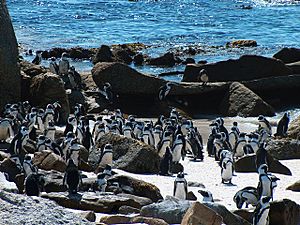
African penguins usually live for 10 to 27 years in the wild. In zoos, they can live up to 30 years. However, African penguins often become prey for other animals.
In the ocean, their predators include sharks, Cape fur seals, and sometimes orcas. On land, enemies include mongooses, genets, caracals, leopards, and domestic cats. The kelp gull also steals their eggs and newborn chicks.
Penguins face more danger from land predators if they have to nest in the open. This happens when there are no good burrows or nest boxes for them to use.
Threats and How We Can Help
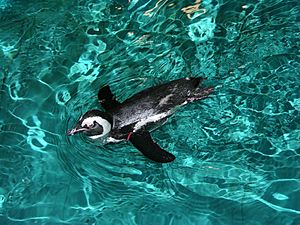
Not long ago, in the mid-1900s, penguin eggs were seen as a special food. People would collect them to sell. Sadly, collectors would break any eggs found a few days before gathering. This was to make sure only fresh ones were sold. This practice, along with removing guano (bird droppings) from islands for fertilizer, hurt the penguin population. Guano was important because penguins used it to dig their burrows.
Penguins are also in danger from pollution in their homes. This includes oil spills from ships and cleaning tankers at sea.
Large-scale fishing for sardines and anchovies, which are the penguins' main food, is also a problem. This forces penguins to swim farther to find food. They also have to eat less nutritious prey.
The African penguin is a species covered by the Agreement on the Conservation of African–Eurasian Migratory Waterbirds (AEWA). In November 2013, the African penguin was listed as endangered on the IUCN Red List of Threatened Species. In September 2010, the US Endangered Species Act also listed it as endangered.
Images for kids
-
African penguin skeleton at the Museum of Osteology in Oklahoma City, Oklahoma, USA
-
African penguin at the Dallas World Aquarium, Dallas, Texas, United States
See also
 In Spanish: Pingüino de El Cabo para niños
In Spanish: Pingüino de El Cabo para niños



